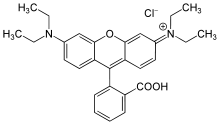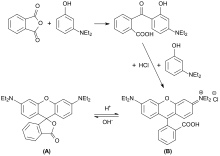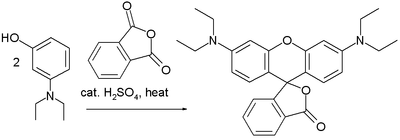Rhodamine B
Rhodamine B /ˈroʊdəmiːn/ is a chemical compound and a dye. It is often used as a tracer dye within water to determine the rate and direction of flow and transport. Rhodamine dyes fluoresce and can thus be detected easily and inexpensively with fluorometers.
 | |
| Names | |
|---|---|
| IUPAC name
[9-(2-carboxyphenyl)-6-diethylamino-3-xanthenylidene]-diethylammonium chloride | |
| Other names
Rhodamine 610, C.I. Pigment Violet 1, Basic Violet 10, C.I. 45170 | |
| Identifiers | |
3D model (JSmol) |
|
| ChEBI | |
| ChEMBL | |
| ChemSpider | |
| ECHA InfoCard | 100.001.259 |
| KEGG | |
PubChem CID |
|
| UNII | |
CompTox Dashboard (EPA) |
|
| |
| |
| Properties | |
| C28H31ClN2O3 | |
| Molar mass | 479.02 |
| Appearance | red to violet powder |
| Melting point | 210 to 211 °C (410 to 412 °F; 483 to 484 K) (Decomposes) |
| 8 to 15 g/L (20 °C)[1][nt 1] | |
| Hazards | |
| Safety data sheet | MSDS |
Except where otherwise noted, data are given for materials in their standard state (at 25 °C [77 °F], 100 kPa). | |
| Infobox references | |
Rhodamine B is used in biology as a staining fluorescent dye, sometimes in combination with auramine O, as the auramine-rhodamine stain to demonstrate acid-fast organisms, notably Mycobacterium. Rhodamine dyes are also used extensively in biotechnology applications such as fluorescence microscopy, flow cytometry, fluorescence correlation spectroscopy and ELISA.
Other uses

Rhodamine B is often mixed with herbicides to show where they have been used.[2]
It is also being tested for use as a biomarker in oral rabies vaccines for wildlife, such as raccoons, to identify animals that have eaten a vaccine bait. The rhodamine is incorporated into the animal's whiskers and teeth.[3]
Rhodamine B (BV10) is mixed with quinacridone magenta (PR122) to make the bright pink watercolor known as Opera Rose.[4]
Properties

Rhodamine B can exist in equilibrium between two forms: an "open"/fluorescent form and a "closed"/nonfluorescent spirolactam form. The "open" form dominates in acidic condition while the "closed" form is colorless in basic condition.[5]
The fluorescence intensity of rhodamine B will decrease as temperature increases.[6]
The solubility of rhodamine B in water varies by manufacturer, and has been reported as 8 g/l and ~15 g/L,[1] while solubility in alcohol (presumably ethanol) has been reported as 15 g/L.[nt 1] Chlorinated tap water decomposes rhodamine B. Rhodamine B solutions adsorb to plastics and should be kept in glass.[7] Rhodamine B is tunable around 610 nm when used as a laser dye.[8] Its luminescence quantum yield is 0.65 in basic ethanol,[9] 0.49 in ethanol,[10] 1.0,[11] and 0.68 in 94% ethanol.[12] The fluorescence yield is temperature dependent;[13] the compound is fluxional in that its excitability is in thermal equilibrium at room temperature.[14]
Synthesis
Safety and health
In California, rhodamine B is suspected to be carcinogenic and thus products containing it must contain a warning on its label.[15] Cases of economically motivated adulteration, where it has been illegally used to impart a red color to chili powder, have come to the attention of food safety regulators.[16]
See also
References
- "Safety data sheet" (PDF). Roth. 2013.
- Cai SS, Stark JD (November 1997). "Evaluation of five fluorescent dyes and triethyl phosphate as atmospheric tracers of agricultural sprays". Journal of Environmental Science & Health Part B. 32 (6): 969–83. doi:10.1080/03601239709373123.
- Slate D, Algeo TP, Nelson KM, Chipman RB, Donovan D, Blanton JD, et al. (December 2009). Bethony JM (ed.). "Oral rabies vaccination in north america: opportunities, complexities, and challenges". PLoS Neglected Tropical Diseases. 3 (12): e549. doi:10.1371/journal.pntd.0000549. PMC 2791170. PMID 20027214.
- MacEvoy B. "Handprint: color making attributes". www.handprint.com.
- Birtalan E, Rudat B, Kölmel DK, Fritz D, Vollrath SB, Schepers U, Bräse S (2011). "Investigating rhodamine B-labeled peptoids: scopes and limitations of its applications". Biopolymers. 96 (5): 694–701. doi:10.1002/bip.21617. PMID 22180914.
- Chauhan VM, Hopper RH, Ali SZ, King EM, Udrea F, Oxley CH, Aylott JW (March 2014). "Thermo-optical characterization of fluorescent rhodamine B based temperature-sensitive nanosensors using a CMOS MEMS micro-hotplate". Sensors and Actuators. B, Chemical. 192: 126–133. doi:10.1016/j.snb.2013.10.042. PMC 4376176. PMID 25844025.
- Bedmar AP, Araguás LA (2002). Detection and Prevention of Leaks from Dams. Taylor & Francis. ISBN 90-5809-355-7.
- Prahl S. "Rhodamine B". OMLC.
- Kubin R (1982). "Fluorescence quantum yields of some rhodamine dyes" (PDF). Journal of Luminescence. 27 (4): 455–462. Bibcode:1982JLum...27..455K. doi:10.1016/0022-2313(82)90045-X.
- Casey KG, Quitevis EL (1988). "Effect of solvent polarity on nonradiative processes in xanthene dyes: Rhodamine B in normal alcohols". The Journal of Physical Chemistry. 92 (23): 6590–6594. doi:10.1021/j100334a023.
- Kellogg RE, Bennett RG (1964). "Radiationless Intermolecular Energy Transfer. III. Determination of Phosphorescence Efficiencies". The Journal of Chemical Physics. 41 (10): 3042–3045. Bibcode:1964JChPh..41.3042K. doi:10.1063/1.1725672.
- Snare M (1982). "The photophysics of rhodamine B". Journal of Photochemistry. 18 (4): 335–346. doi:10.1016/0047-2670(82)87023-8.
- Karstens T, Kobs K (1980). "Rhodamine B and rhodamine 101 as reference substances for fluorescence quantum yield measurements". The Journal of Physical Chemistry. 84 (14): 1871–1872. doi:10.1021/j100451a030.
- Strack R (May 2019). "Bypassing bleaching with fluxional fluorophores". Nature Methods (Paper). 16 (5): 357. doi:10.1038/s41592-019-0402-2. PMID 31040423.(subscription required)
- "Naval Jelly MSDS with Rhodamine B" (PDF). Locite Corporation. 20 October 1998. Archived from the original (PDF) on 2010-04-15.
- Lin S (2015). "Rapid and sensitive SERS method for determination of Rhodamine B in chili powder with paper-based substrates". Analytical Methods. 7 (12): 5289. doi:10.1039/c5ay00028a. Retrieved 1 February 2018.
Notes
- Ellis RC (November 16, 2015). "Reagent and Dye Solubility Chart". IHCWorld. Retrieved 9 February 2020.
This is to be used as a guide only as solubility data varies between manufacturers for the same product, especially for dyes.
Note that most sources simply indicate that the compound is water soluble without providing a g/l value.
